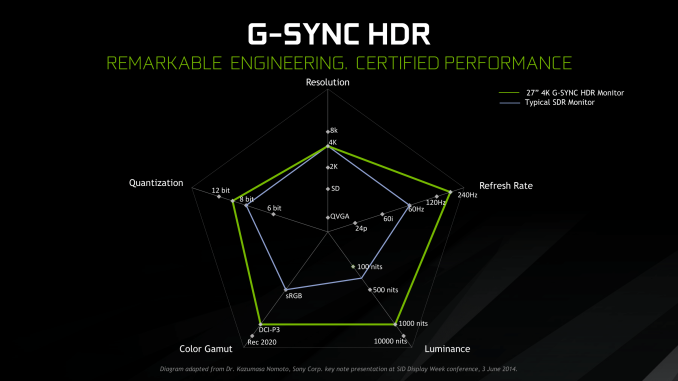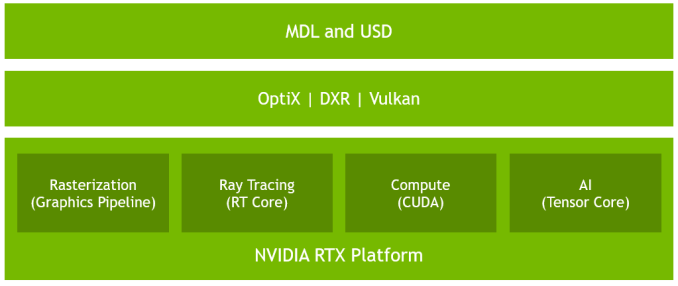The NVIDIA GeForce RTX 2080 Ti & RTX 2080 Founders Edition Review: Foundations For A Ray Traced Future
by Nate Oh on September 19, 2018 5:15 PM EST- Posted in
- GPUs
- Raytrace
- GeForce
- NVIDIA
- DirectX Raytracing
- Turing
- GeForce RTX
Meet The New Future of Gaming: Different Than The Old One
Up until last month, NVIDIA had been pushing a different, more conventional future for gaming and video cards, perhaps best exemplified by their recent launch of 27-in 4K G-Sync HDR monitors, courtesy of Asus and Acer. The specifications and display represented – and still represents – the aspired capabilities of PC gaming graphics: 4K resolution, 144 Hz refresh rate with G-Sync variable refresh, and high-quality HDR. The future was maxing out graphics settings on a game with high visual fidelity, enabling HDR, and rendering at 4K with triple-digit average framerate on a large screen. That target was not achievable by current performance, at least, certainly not by single-GPU cards. In the past, multi-GPU configurations were a stronger option provided that stuttering was not an issue, but recent years have seen both AMD and NVIDIA take a step back from CrossFireX and SLI, respectively.
Particularly with HDR, NVIDIA expressed a qualitative rather than quantitative enhancement in the gaming experience. Faster framerates and higher resolutions were more known quantities, easily demoed and with more intuitive benefits – though in the past there was the perception of 30fps as cinematic, and currently 1080p still remains stubbornly popular – where higher resolution means more possibility for details, higher even framerates meant smoother gameplay and video. Variable refresh rate technology soon followed, resolving the screen-tearing/V-Sync input lag dilemma, though again it took time to catch on to where it is now – nigh mandatory for a higher-end gaming monitor.
For gaming displays, HDR was substantively different than adding graphical details or allowing smoother gameplay and playback, because it meant a new dimension of ‘more possible colors’ and ‘brighter whites and darker blacks’ to gaming. Because HDR capability required support from the entire graphical chain, as well as high-quality HDR monitor and content to fully take advantage, it was harder to showcase. Added to the other aspects of high-end gaming graphics and pending the further development of VR, this was the future on the horizon for GPUs.
But today NVIDIA is switching gears, going to the fundamental way computer graphics are modelled in games today. Of the more realistic rendering processes, light can be emulated as rays that emit from their respective sources, but computing even a subset of the number of rays and their interactions (reflection, refraction, etc.) in a bounded space is so intensive that real time rendering was impossible. But to get the performance needed to render in real time, rasterization essentially boils down 3D objects as 2D representations to simplify the computations, significantly faking the behavior of light.
It’s on real time ray tracing that NVIDIA is staking its claim with GeForce RTX and Turing’s RT Cores. Covered more in-depth in our architecture article, NVIDIA’s real time ray tracing implementation takes all the shortcuts it can get, incorporating select real time ray tracing effects with significant denoising but keeping rasterization for everything else. Unfortunately, this hybrid rendering isn’t orthogonal to the previous concepts. Now, the ultimate experience would be hybrid rendered 4K with HDR support at high, steady, and variable framerates, though GPUs didn’t have enough performance to get to that point under traditional rasterization.
There’s a still a performance cost incurred with real time ray tracing effects, except right now only NVIDIA and developers have a clear idea of what it is. What we can say is that utilizing real time ray tracing effects in games may require sacrificing some or all three of high resolution, ultra high framerates, and HDR. HDR is limited by game support more than anything else. But the first two have arguably minimum performance standards when it comes to modern high-end gaming on PC – anything under 1080p is completely unpalatable, and anything under 30fps or more realistically 45 to 60fps hurts the playability. Variable refresh rate can mitigate the latter and framedrops are temporary, but low resolution is forever.
Ultimately, the real time ray tracing support needs to be implemented by developers via a supporting API like DXR – and many have been working hard on doing so – but currently there is no public timeline of application support for real time ray tracing, Tensor Core accelerated AI features, and Turing advanced shading. The list of games with support for Turing features - collectively called the RTX platform - will be available and updated on NVIDIA's site.













337 Comments
View All Comments
tamalero - Wednesday, September 19, 2018 - link
Unlike a video card, DVD were a STANDARD. set to replace the DVD. This wasn't a war between BETAMAX and VHS again. It was an evolution.And as you said it, they had a few titles coming on.
Nvidia currently is offering ZERO options for what they charge insanely.
Even those 4k TVs you mentioned.. had demos and downlodable content.
It was the future.
Nvidia's game in some of these RTX features are solely of Nvidia, not a global standard.
tamalero - Wednesday, September 19, 2018 - link
Errata: set to replace the "CDS" not DVDs.. They do really need an edit button here.Writer's Block - Monday, October 1, 2018 - link
Not a great comparrison.Mainly because: games making use of RTX and othe new features is: Zero.
OlED and 4k/DVD/Blue: pretty much zero/extremely small/dozen or so - not of the aforementioned is as low as zero, so the consumer could see what they were getting.
boozed - Wednesday, September 19, 2018 - link
Early adopters have always paid over the odds for an immature experience. That's the decision they make. You pays your money and you takes your chances...Gastec - Thursday, September 27, 2018 - link
Yes, drug addicts would also agreeianmills - Wednesday, September 19, 2018 - link
RTX - Radeon technology cross off the list. Nvidia is free to price as they please XDNikosD - Wednesday, September 19, 2018 - link
1080 Ti vs 980 Ti ~ 70% for 50$ more MSRP1080 vs 980 ~ 60% for 50$ more MSRP
2080 Ti vs 1080 Ti ~ 30% for 300$ more MSRP (actual price difference is a lot more)
Please, let's boycott Turing cards.
nVidia must learn its lesson.
Skip it.
V900 - Wednesday, September 19, 2018 - link
If you look at AMDs Vega and compare it with the previous AMD flagship: Fury, you see a similar 30-40% increase in performance.In other words: This isn’t Nvidia wanting to rip gamers off, it’s just a consequence of GPU makers pushing up against the end of Moore’s law.
formulaLS - Wednesday, September 19, 2018 - link
It IS nVidia wanting to rip off gamers. Their prices are absolutely a huge rip off for what you get.DigitalFreak - Wednesday, September 19, 2018 - link
Blame AMD for not competing. Nvidia would never be able to do this if AMD had a competitive offering.